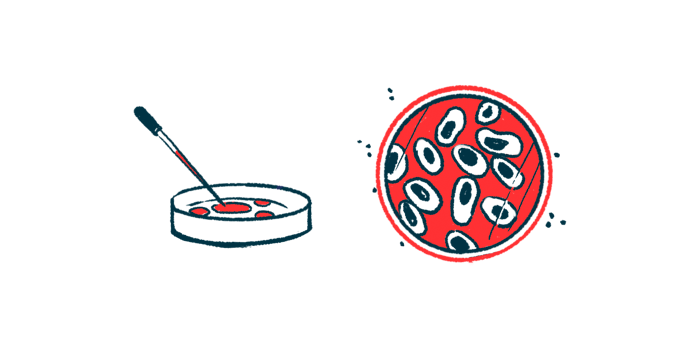P. Aeruginosa Metabolites May Enable Better Patient Management
Written by |

Molecules produced by the environmental bacteria Pseudomonas aeruginosa, called alkyl-quinolones derivatives — which regulate bacterial gene activity and act in cell-to-cell communication — may be useful markers for better management of patients with cystic fibrosis (CF), a study suggests.
These derivatives also may enable a more clear definition of the clinical stages of infection with the bacteria, known as P. aeruginosa, which is key in CF lung disease, the scientists said.
Moreover, the team said, the alkyl-quinolones derivatives may allow better grouping of CF patients in clinical trials.
The study, “Alkyl-Quinolones derivatives as potential biomarkers for Pseudomonas aeruginosa infection chronicity in Cystic Fibrosis,” was published in the journal Scientific Reports.
P. aeruginosa infections are composed of three clinical stages: initial, intermittent, and chronic. Changes to genetic and other traits in the bacteria are tied to chronic infections, difficult or impossible eradication of P. aeruginosa, declined lung function, and worse health outcomes.
Given these associations, “it would be interesting to be able to rapidly define and characterize the stage of colonisation/infection in order to better adapt the respiratory sampling and analysis, the therapeutic management of the patients and to develop strategies to counteract this implantation,” the researchers wrote.
According to existing definitions, at least six months are needed before a chronic infection can be determined, which limits therapeutic follow-up among people with CF. One possible way to track Pseudomonas implantation and progression is to use metabolomics, the large-scale study of small molecules known as metabolites. In fact, the metabolome of P. aeruginosa changes over time and includes different types of molecules that help colonize the respiratory tract.
In this study, a team from France and Switzerland looked at the metabolic profiles of 44 strains of P. aeruginosa, from 34 patients with CF at different stages of infection. All of the patients were followed in Lyon, France. The researchers’ goal was to evaluate the different metabolites produced and link them to the different stages of infection.
Of the 44 strains isolated, nearly half — 20 strains — were derived from 10 patients with chronic infection, which means the bacteria were detected in at least 50% of sputum samples analyzed in the previous year. Nine strains came from patients who had never been colonized by P. aeruginosa, while 10 strains came from 10 patients who were free from the bacteria for at least one year before the isolation of this strain. The remaining five strains were from five patients with intermittent infection, meaning they had at least one positive P. aeruginosa culture.
Of note, colonization is not the same as infection. Colonization means a patient has enough organisms at a site that they can be detected, but the organism is not causing signs or symptoms.
Analyzing all of the P. aeruginosa strains using a UV method showed a distinction between those with a first-time colonization and those with chronic colonization. The other two groups, those who hadn’t had P. aeruginosa in the last year and those with intermittent colonization, ranged in between.
The samples were then further analyzed and 12 compounds were detected: seven in the nutrient liquid and five that were identified as alkyl-quinolones derivatives, or metabolites.
The seven compounds found in the nutrient liquid were at higher levels in the chronic infection samples than in the newly colonized.
Among the alkyl-quinolones derivatives, three — HQC5, HQNOC7 and HQNOC7:1 — were found at higher levels in those samples from patients who had been colonized before, but not in the last year, as compared with those chronically infected.
One compound, dbPQSC9, was higher in those who were newly colonized, in comparison with those chronically infected.
The fifth alkyl-quinolones molecule, HQNOC9:1, was found at higher levels in both the newly colonized and those who had been colonized before, but not in the last year, as compared with the chronically colonized. This compound had the most significant difference between these groups.
Subsequent analysis further indicated that alkyl-quinolones derivatives are produced more in earlier stages of colonization.
However, other compounds, such as HHQ (HQC7), were found in high proportions in chronically infected, close to or higher than those in newly infected and those with no infections in the last year.
The researchers found that in chronic infections, HHQ concentration may be very important when compared with HQNOC9:1. In those with new infections, the concentration of HQNOC9:1 tends to be closer to that of HHQ, the team also found.
As such, the team hypothesized that comparing the ratio between HHQ and HQNOC9:1 could potentially indicate the P. aeruginosa infection stage in patients with CF. The results did reveal a significant difference in the ratio between chronic and new infections.
Overall, the researchers suggested that the overproduction of some of the alkyl-quinolones derivatives — those linked to the “invasive” strains in the newly infected and those who hadn’t been infected in a year — could be due to the fact that these bacteria need to infect and colonize an environment that may already be inundated with other bacteria. This is different than what happens in chronic infections. One such example, HQNOC9:1, has been shown to inhibit the growth of other bacteria.
“Our study suggests that some AQ [alkyl-quinolones] derivatives can be used as biomarkers for an improved management of CF patients as well as a better definition of the clinical stages of Pa [P. aeruginosa] infection,” the investigators wrote.
“The implementation of a metabolic approach could also lead to a better understanding of the physiopathology [processes] of the disease and then let us imagine new approaches to avoid CF lungs’ colonisation by Pa and/or to eradicate this bacterium from the lower airways,” they added.
Additionally, the analysis of these derivatives may allow for the potential development of better diagnostic tools and a better understanding of the disease’s progression, facilitating new approaches to avoid lung colonization by this bacteria.
Among the study limitations, the scientists mentioned the low number of strains in each group, which warrants analysis of a larger number of samples.








